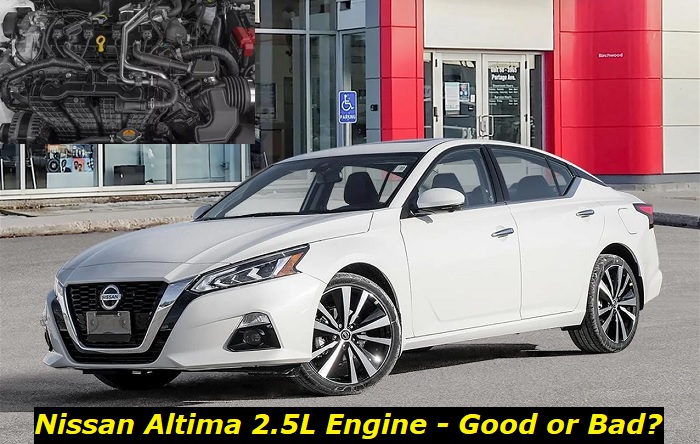The Nissan Altima is one of the longest-running mid-size cars of its brand. It has been around since 1992 and is still one of the in-demand cars of its brand today. There are many things that the product is known for like its wide array of trim levels catered to the different preferences of buyers in terms of price, performance, style, comfort, fuel economy, tech, safety, and reliability.
However, what makes it significantly stand out from the competition is its good resale value.
The luxurious offerings of the Altima sit above the Sentra and a notch down from the Maxima. With that, there are definitely a lot of things that we can discuss about the car. But then again, we will only streamline our assessment on the 2.5L engine that's carried by its lower-trim models.

Key features and my opinion about the engine
- Production years:2018-2024
- Average lifespan of PR25DD:190,000-220,000 miles
- Fuel supply type:direct injection
- Power range:184-188 hp
- Fuel efficiency:good
- Engine block material:aluminum
- Engine reliability score:medium
- The most common problems:start-stop glitching, carbon buildup on intake valves, EGR valve contamination, no hydraulic lifters.
Key Specs of the 2022 Nissan Altima 2.5L Engine
Equipped in the sixth-generation Nissan Altima (L34) is the 2.5L engine also referred to as the PR25DD, or simply PR25. Aside from the car, the other known applications of the engine include the X-Trail compact crossover and Rogue mid-size crossover. It made its way to the Outlander crossover of Mitsubishi as well.
The engine features a small size with an inline-four layout, which makes it ideal for a mid-size car. It comes with an all-aluminum block and head to keep the vehicle's weight down while optimizing power production and keeping the number of moving parts low to reduce the risk of overheating. It should be noted though that due to its utilization of a lighter material, the powerplant is more susceptible to warping under extreme temperatures or pressure because it is less durable than its cast-iron counterpart.
The PR25 has a 2,488 cc displacement complemented by natural aspiration to help promote air and fuel circulation in the engine, which translates to more output produced. Meanwhile, it is designed with a bore of 89 mm and a stroke of 100 mm to maintain the ideal torque with every rev of the auto and to keep the fuel economy plus emissions within acceptable levels. In addition, such a setup helps support a high compression ratio of 12.0:1. The high thermal efficiency means a higher rate of conversion from the engine combustion event paving the way to higher outputs.
Moreover, a dual overhead cam (DOHC) with four valves per cylinder governs airflow at high engine speeds. Likewise, the configuration gives way to the positioning of the spark plug in between the combustion chamber for efficient fuel burn and power production. This is partnered with Nissan's continuous valve timing system (CVTCS) to further let the engine breathe easier.
Lastly, it utilizes a direct injection system for high-precision fuel delivery, power optimization, and fuel economy. Speaking of fuel economy, the Altima has an estimated range of 22-23 mpg in city drives, 31-33 mpg in highway cruises, and 26-27 mpg combined.
Overall, the 2.5L engine has a redline of 6,200 rpm. It can deliver up to 188 hp at 6,000 rpm and 180 lb-ft of torque at 3,600 rpm. Matched with a front-wheel-drive system and continuously variable transmission (CVT), the power unit launches a properly-equipped 2022 Altima from a standstill to 60 mph in just 6.2 seconds and capping at a max speed of 130 mph.
Longevity of the 2022 Nissan Altima 2.5L Engine
The Nissan Altima has a range of 250,000 to 300,000 miles before requiring engine overhaul or replacement as well as other uneconomical repairs. The said figures equate to an average lifespan of 15 to 20 years based on the average driver's annual mileage.
It is not uncommon for Nissan Altima cars to last over 200,000 miles, depending on factors such as maintenance and driving style. The best way to go near or surpass those numbers is to ensure that its preventive maintenance schedules are followed and that repairs are conducted in a timely manner upon the early signs of trouble
Most Common Problems Found in the 2022 Nissan Altima 2.5L Engine
The Nissan Altima 2.5L engine was only introduced in 2018, so it's only four years old as of 2022. With that short span, there are no solid statistics relating to its engine breakdowns yet. However, based on the commonly reported problems of the car, here are the ones that appear to have the highest risk of occurrence:
1. Intake Valves Prone to Soot
Due to the use of a direct injection system in the 2022 Altima 2.5L engine, the intake valves are prone to soot accumulation. This can result in a loss of power and fuel economy, and the engine may run roughly.
To diagnose soot clogs in the intake valves, start by checking for any visual signs of deposits on them. Next, perform a compression test to check for any pressure loss. Finally, check the oxygen sensor readings to see if they are outside of the normal range.
If the cause of the soot accumulation is not addressed, it will eventually lead to engine damage. The most common solution is to clean the intake valves through a process called walnut blasting. This involves using a high-pressure stream of walnut shells to remove the soot deposits.
If cleaning no longer comes as a viable solution, there may be a need to replace the intake valves with new ones. However, depending on the severity of the problem, other parts such as the piston rings and cylinder head may also need to be replaced.
2. Dirty EGR
The exhaust gas recirculation (EGR) system in the 2022 Nissan Altima 2.5L engine is designed to reduce emissions by recirculating a portion of the exhaust gases back into the engine cylinders.
Dirty or faulty EGR valves can cause a number of problems, including reduced fuel economy, loss of power and torque, increased emissions, rough idling, and stalling.
If you're experiencing any of these symptoms, it's possible that your EGR system is dirty and needs to be cleaned. Cleaning the EGR can be done by removing the EGR valve and using a brush or compressed air to clean the carbon deposits from the valve and passages.
On the other hand, if the component is already beyond repair, it has to be replaced as soon as possible. Dirty or faulty EGR systems can cause serious damage to your engine if left unchecked.
Other parts that may need to be replaced if the repair is delayed include the EGR cooler, intake manifold, and exhaust manifold.
3. Valves Frequently Need Recalibration
The absence of hydraulic lifters in the 2.5L Altima engine means the valves must be adjusted every 62,000 miles. If the valves are not timed correctly, your engine will not run as efficiently as it could.
The first symptom of incorrect valve timing is usually a loss of power. The engine will feel sluggish and may even stall when idling.
If the problem is not addressed, the fuel economy will suffer and the engine will eventually overheat. Overheating can lead to serious engine damage, so it is important to act quickly if you notice this symptom.
To fix the problem, you will need to adjust the valves. This is a simple process that can be done in your driveway with basic mechanical skills.
First, locate the adjustment screws on the top of the engine. There are two screws, one for each cylinder.
Next, use a wrench to turn the screws until the engine is running smoothly again. It is important to turn both screws the same amount so that the engine runs evenly.
Once the engine is running smoothly, you can drive it for a few hundred miles to make sure the problem is fixed. If the problem persists, you may need to replace some of the parts in your engine.
If you're unsure about the process, feel free to contact your mechanic for advice, or better, have them perform the task for you.
4. Start/Stop System Glitches
If your Nissan Altima's Start/Stop system is experiencing glitches, there are a few things you can do to diagnose the issue and find a solution.
First, check the battery. If the battery is low on power, it may be causing the Start/Stop system to malfunction. Try charging the battery or replacing it with a new one.
If the battery isn't the problem, then it's likely an issue with one of the engine's sensors. The most common sensor issues are with the crankshaft position sensor or the camshaft position sensor. To test these sensors, you'll need a multimeter. If either of these sensors is defective, it will need to be replaced.
Once you've replaced the defective sensor, the Start/Stop system should be back to normal. However, if you're still having trouble with the Start/Stop system, there may be an issue with the starter motor. This is a more serious problem that will require professional help to fix.
If your Nissan Altima's Start/Stop system is giving you trouble, don't hesitate to get it checked out. By troubleshooting the problem and replacing any defective parts as early as you can, you can get your car back to running smoothly in no time.
Conclusion
The 2.5L PR25DD engine used by the 2022 Nissan Altima only started its production in 2018. Therefore, we are yet to discover whether or not there are other more serious issues with the engine aside from the ones shown here.
Based on what we have uncovered though, it is a very reliable engine with amazing performance and the potential to last over 200,000 miles or even 300,000 miles with proper care. For now, this one gets our thumbs up when it comes to reliability because of the facts presented here.
About the authors
The CarAraC research team is composed of seasoned auto mechanics and automotive industry professionals, including individuals with advanced degrees and certifications in their field. Our team members boast prestigious credentials, reflecting their extensive knowledge and skills. These qualifications include: IMI: Institute of the Motor Industry, ASE-Certified Master Automobile Technicians; Coventry University, Graduate of MA in Automotive Journalism; Politecnico di Torino, Italy, MS Automotive Engineering; Ss. Cyril and Methodius University in Skopje, Mechanical University in Skopje; TOC Automotive College; DHA Suffa University, Department of Mechanical Engineering






Add comment